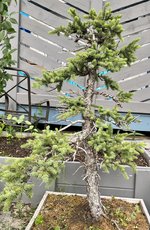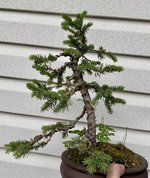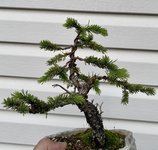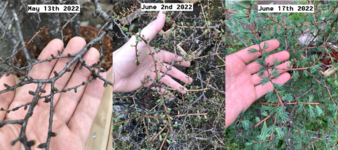June has been rough going. Within only a few weeks of each other I lost five of my six collected Black spruce. All of the symptoms were the same. Sudden drying of the needles followed by yellowing and finally massive needle drop. It's a little heartbreaking as I was excited about them, but I need to look at this in a logical way. I obviously did something wrong. So changes must be made to how I collect and care for these trees. I'm hoping this will be a valuable learning experience. I don't believe in hiding my failures.
Here are some key points.
- All but one of the trees were collected in late fall. About a month before the first snow. The other tree was collected in early spring.
- Most of these trees had excellent root systems when they came out of the ground. None were bare rooted.
- They were planted in wooden boxes made from recycled pallet wood (not pressure treated or painted).
- The substrate for all but one was 1/4" fir bark. Good drainage and doesn't decompose quickly. One of the smaller trees was planted in pure living sphagnum (this tree had poor roots but was the last to die...).
- All trees appeared to survive winter and spring. It was only during June that they rapidly declined.
- They were watered attentively. Kept moist but not sopping wet. I also misted the foliage to maintain humidity.
- In the Fall, I had my trees on a table I built from scrap wood, but later moved them to the ground.
- They were placed on the leeward side of the house, protected from the harsh wind, and received morning sun/afternoon shade.
- Interestingly, my Tamaracks are doing just fine and pushing new needles like crazy. They were treated the same way.
- I have one Spruce left which was collected later in the season. I'll admit that I did a much better job at transplanting this one. But I'll be watching it very closely.
So, what do you think? I have a few hypotheses.
1. Collecting Spruce in late fall might have been a mistake. Since they put on most of their root growth in the fall season, I might have undone what the tree worked hard to build during the previous weeks/months.
2. Heat sensitivity. Is it true that Spruce move water much less efficiently than a Tamarack (Larch)? This coupled with root damage during collection may have prevented the Spruce from cooling themselves adequately.
3. Root damage from the cold? They appeared totally fine in the spring. However they showed no signs of new growth.
4. Too rough/aggressive with the roots + Poor anchoring. Many of my earlier trees wobbled a lot. I've since become much better at anchoring my trees.
Please let me know your thoughts.
Disclaimer: The following is not advice, but in case they're useful, here are some positions I've taken on fall collection of conifers (and also deciduous) that have served me well (you already seem to know most of these):
1. If you collect in fall and you're at least as cold as where I am (zone 8), use a heat mat to keep roots well above 0C.
2. Raising the temperature to a (24/7/all winter long) 20 to 25C is even better, and can yield outstanding success and help the tree "hit the ground running" in spring.
Heat mats are so outrageously amazing at their job that I've managed to bare root a lodgepole pine yamadori and it filled a pond basket with roots without skipping a beat -- YMMV with non-pine, but still, they are magic. Given that they are so inexpensive and easy to find online, a really important part of a collectors toolkit if they live in a colder area or must collect in fall to avoid mountain snow / closed roads (or both).
3. The above points shouldn't be misinterpreted as keeping a conifer indoors, or in a space that goes above 7C during winter
4. Recover conifers in coarse pumice or coarse perlite and not in organic substrates. YMMV, but not using pumice just shifts the inevitable to later IMO. I have not had great results recovering conifers in bulk, but they may have been more air-thirsty than a spruce.
5. Trees should not move and wind cannot be a lever on the trunk. Boxes shouldn't flex at all if they need to move. If I've used an anderson flat as a recovery box for a tree, I've reinforced it with wood somewhere so that it doesn't flex. The sound of pumice undergoing shear as I lift a grow box after a few weeks of recovery is a sound I want to avoid at all costs. I will carefully slide a firm metal plate under a box and lift the plate instead of the box if that's what it takes to have no flex. They're only getting moved once or twice for urgent reasons before the growing season anyway.
6. Conifers shouldn't be watered excessively during the first few months of recovery.
7. IME, recovery is significantly quicker and feels more durable when a conifer is kept in full sun. For me, has applied equally well for pine as for subalpine fir, etc.
8. The size of recovery container should be a minimal bounding box around the volume of the root system / soil cake you extracted from the ground. Oversizing = trouble, a recovering tree doesn't cycle water out of soil very fast.
If I was to guess what went wrong for you, I would guess that things got far too cold and that the trunk levering / moving didn't help. The latter of those is easy to fix.
If you can, give heating mats a try. Even the least expensive vivosun-brand ones are used by professionals (both field growers and multiple bonsai educators) in my area and seem to work great, but if you want super heavy duty ones that can
really push some watts when it gets super cold and can hold up to industrial abuse, the heavy horticultural-grade ones are great, and probably have an excellent resale value down the road in case you're concerned about budget (as would the controller/sensors).
If I was playing this game in northern Ontario/Quebec/Manitoba/Alberta, I'd probably set up heat mats and then bury the recovery boxes in a large "heat battery" of very heavy but very coarse locally-available gravel to act as a thermal reservoir during the worse sections of winter. I've done this with lava, and it works amazingly well at soaking up all those extra Watts you're paying for and keeping things toasty. To maximize the use of every single watt/bit of heat, I cluster as many trees as possible over the mats to insulate much as possible and prevent any leakage. Keep in mind that the root systems can stay toasty without waking up the canopy.













